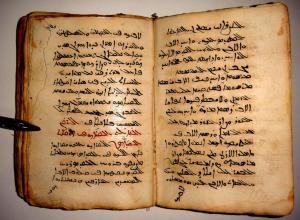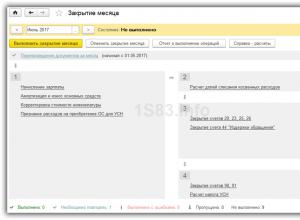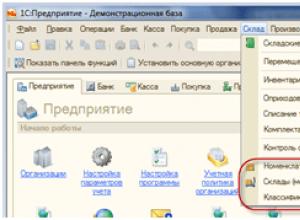Cashier's report cover page sample. How to maintain a cash book: example of filling. How to correct mistakes made
Any organization is obliged to conduct cash book (form N KO-4), if he receives or spends cash. The cash book is maintained by a cashier or other employee whose job responsibilities include conducting cash transactions. Control over the maintenance of the cash book is assigned to the chief accountant (in his absence, to the manager).
Registration of the cash book
The cash book can be maintained in one of three ways: by hand, on a computer or electronically.
The cash book is filled out by hand
Before you start working with the cash book, its sheets must be numbered and laced. The number of sheets is indicated on the last page of the cash book and is certified by the signatures of the chief accountant and the head of the organization and the seal of the organization.
Entries in the book must be made in ink or a ballpoint pen.
Each sheet of the book consists of two identical parts (copies):
the first always remains in the book;
the second is tear-off.
The algorithm for filling out the cash book is as follows:
1. At the beginning of the shift, the cashier, that is, an employee whose job responsibilities include conducting cash transactions:
along the dotted line (cut line), folds the tear-off part of the sheet under the first one and places carbon paper between them;
indicates the date and amount of the cash balance at the beginning of the day, which is always equal to the balance at the end of the previous business day in which cash transactions were carried out.
2. During the day, the cashier makes line-by-line entries in the cash book about each receipt and expenditure order (PKO) and cash outflow order (RKO), issued for cash received and issued, respectively.
The “Transfer” line of the cash book with the total amount of cash received and issued to this point is filled in:
or at the end of the shift;
or when one page of the sheet was not enough for records for the shift.
If one sheet of the book was not enough for all the entries for the shift, the entries are made on the next sheet, in which the same date is indicated in the “Cash for” line.
3. At the end of the shift, the cashier:
calculates and indicates in the cash book the total amount of money received and issued (cash turnover) and the cash balance at the end of the day. In this case, the amount intended for the payment of wages according to the payroll or payroll is indicated additionally in the line “including wages, social payments and scholarships”;
puts his signature in the cash book and indicates his surname and initials.
4. After this, the cashier passes the cash book along with the PKO and RKO received for the day to the accountant or chief accountant.
5. The accountant, having checked the entries in the cash book with the data of PKO and RKO:
indicates in the cash book in words the total number of cash receipts received and the total number of cash receipts received and signs;
returns the book to the cashier, keeping the PKO, RKO and the tear-off part of the sheet of the cash book.
Moreover, if no cash transactions were carried out during the working day, no entries are made in the cash book.
The cash book is filled out on the computer
In this case, the cash book can be maintained in an accounting program (for example, 1C) or in another convenient computer program.
Entries in such a cash book are made in the same way as when filling out a cash book by hand.
At the end of each working day, the cashier prints out and signs 2 copies of the cash book sheet, which he takes to the accountant along with the PKO and RKO issued for the day. Reconciliation of the cash book data with the PKO and RKO data is carried out in the same way as when filling out the cash book by hand.
At least once a year, printed sheets of the cash book must be stitched, indicating their total number on the back of the last page. Then the head of the organization puts their signatures on this page and affixes the seal of the organization.
The cash book is maintained electronically
In this case, the cash book is drawn up using technical means that ensure its protection from unauthorized access, distortion and loss of information, and is signed with electronic signatures.
Cash book storage period
Cash documents and books, PKO and RKO accounting journals, bank documents, bank checkbook counterfoils, advance reports, cash audit documents must be stored in the organization for five years.
Upon expiration of the storage period for documentation, it must be destroyed.
Administrative responsibility
If the organization does not maintain a cash book or entries are not made in it or are made untimely, then a fine will be imposed:
- for its manager in the amount of 4,000 to 5,000 rubles.
for organization in the amount of 40,000 to 50,000 rubles;
Still have questions about accounting and taxes? Ask them on the accounting forum.
Cash book: details for an accountant
- Cash book and journal of the cashier-operator at the individual entrepreneur
Fill out the cashier-operator's log? About the cash book An individual entrepreneur, including... public catering, may not keep a cash book and documents based on... in this book. (Entries in the cash book (f. 0310004) are made by the cashier... documents, and also not keeping a cash book. Let's add: the same thing... Note: the exemption from maintaining a cash book does not apply to an individual entrepreneur who is... an entrepreneur definitely may not maintain a cash book and documents, based on...
- Organization of cash payments in an autonomous institution
Up to 50,000 rub. Maintaining a cash book Cash received and issued... must be recorded in the cash book (f. 0504514). The entries in it... to the warrant. According to the changes made, now not only the cashier can maintain a cash book... of the money reflected in the cash book, and certifies the entries in the cash book with a signature. You can't leave...
- The procedure for conducting cash transactions has been simplified
Preparation of cash documents and maintaining the cash book. The features of registration of cash documents... registration of cash documents and maintaining a cash book are determined. The features of registration of cash documents... based on fiscal documents are determined. On maintaining the cash book According to clause 4.6 of the Procedure... the data contained in the cash book was verified. And now he checks the actual... cash balance reflected in the cash book. The procedure for issuing electronic documents has been clarified...
- The procedure for processing cash transactions and issuing funds for reporting has been changed
A legal entity records money in the cash book (f. 0310004) (clause 4.6 ... Instructions No. 3210-U). Entries in the cash book (f. 0310004) are made for each... which follows that entries in the cash book (f. 0310004) can be made not... reflected in the cash book (f. 0310004), and certifies the entries in the cash register book (f. 0310004 ... (f. 031001, 0310002), attached to the cash book, must meet the requirements established by law ...
- Changes have been made to the procedure for conducting cash transactions
Cash documents on paper. Cash book. Cash received and issued to the cash register must be recorded in the cash book (f. 0310004). Entries in it... Instruction No. 4416-U provides for the maintenance of a cash book not only by the cashier, but also... reflected in the cash book (f. 0310004), and certifies the entries in the cash book (f. 0310004 ...
- New procedure for cash transactions and issuing money on account
Be certified with an electronic signature. Entries in the cash book in connection with amendments may... . Previously, the cashier checked the data in the cash book with cash documents, output the amount... and the balance of funds in the cash book. Registration of incoming and outgoing cash...
Cash book form KO-4 is a document designed to reflect the movement of cash through the cash desk of an enterprise. Maintaining the cash book is the responsibility of the responsible cashier or accountant; entries are made if there are supporting documents (receipt and expense cash documents).
The cash book must be numbered, laced, the number of sheets certified by the signatures of the chief accountant and manager, as well as the seal of the organization.
Maintaining a cash book in form KO-4 is a mandatory procedure for every organization that carries out cash payments; the correctness of filling out this form is regularly checked by the tax authority. Entries in form KO-4 are made daily with each receipt or issue of cash.
On a note! We also offer forms and samples of documents that the cashier-operator must fill out daily: log KM-4 - , information on form KM-7 - .
Sample filling
Filling out the cover of the cash book KO-4:
Organization: name of the organization, OKPO, name of the structural unit.
Cash book for: The validity period of this form is indicated. Typically this is a calendar year.
Filling out the sheets of the book:
If the cash book is filled out manually, then before making an entry on a new sheet, it is bent along the cut line so that the tear-off part of the back side is under the non-tear-off part of the front side. A carbon copy is placed between them, after which entries begin to be made with a pen, and the completed data is repeated on the second sheet.
To prevent the lines from getting mixed up, it is necessary not to change anything during the day, not to tear it off, not to move it.
The current date and sheet number are indicated at the top.
Balance at the beginning of the day: the balance of cash in the company's cash register at the beginning of the working day.
Document number: the number indicated on the cash document on the basis of which funds were received or issued (number or).
Received from/issued to: Full name of the person or name of the organization, as well as a brief summary of the transaction.
Account number: the number of the accounting account corresponding to the cash account account 50 “Cash” depends on the content of the transaction (accounts 51, 70, 71, 62, 60, 76, etc.).
Receipt: indicates the amount of cash received at the cash desk, in rubles and kopecks.
Expense: indicates the amount issued from the cash register in rubles and kopecks.
Thus, each cash transaction is reflected in the KO-4 cash book form up to the “transfer” line. In the “Transfer” line, the total values for debit and credit (income and expense) are calculated.
After this, the sheet is unbent and bent in such a way that the back side of the non-tearable part is above the front side of the tear-off part. In the same way, a carbon copy is placed between them and notes are made.
Total for the day: the results for the working day are summed up, the turnover of debit and credit (income and expense) is calculated.
Balance at the end of the day: the amount of cash in the cash register at the end of the working day is calculated taking into account the balance at the beginning of the day and the debit and credit turnover for the day.
Signatures: the sheet of the KO-4 form is signed by the cashier responsible for maintaining the cash book, indicating the number of incoming and outgoing cash documents on the basis of which entries were made in the KO-4 form.
After this, a copy of the records for the day is torn off and, together with the cash documents, is attached to the cashier-operator’s report, form KM-6 () and transferred to the accounting department.
The original entries remain in the cash book.
If an error is made in the cash book, it can be corrected by crossing out and indicating the correct information next to it; the correction must be certified by the signatures of the chief accountant and cashier.
If the KO-4 form is maintained electronically, then at the end of the working day two copies of the sheet with records for the day are printed, one is transferred to the accounting department, the other is filed in a special folder.
The unified form of the cash book is indicated as KO-4 (Resolution of the State Statistics Committee of the Russian Federation dated August 18, 1998 No. 88). Both business enterprises and budgetary and non-profit organizations can use a cash book both in paper and electronic form.
Since 2013, maintaining a cash book is not mandatory; now this decision is made by the institution independently. The document form can be developed and secured by local regulations of the organization. In the article you will find instructions on how to fill out the cash book, a sample is also attached.
How to fill out a cash book
So, you have a cash book, how to properly manage 2019? The process follows this pattern. The cashier must be responsible for the cash register (clause 4, clause 4.6, clause 4 of Instructions No. 3210-U). If there is no cashier position in the institution, another accounting employee, who is indicated directly by the head in the relevant order, is responsible for maintaining the cash book. The control function remains with the chief accountant. Each organization actually regulates the cash flow process itself. In budgetary institutions where there is a constant flow of funds, a cash book must be present. The maintenance of the cash book in 2019 can be reflected in the following general diagram:
- The cashier collects balances daily at the beginning and end of the working day. These amounts must be equal. If no operations were performed on any day, the arch need not be formed. The balance will automatically be transferred to the next day.
- The arrival (receipt) of funds is registered, cash issuance is carried out through. Numbers for each of these documents are assigned in order, and information about them is reflected in the cash book.
- On days when there was cash movement, the cashier will complete his work by summing up the results of the billing period. The book reflects all daily transactions and is certified by the signature of the responsible employee. All movements and their entries in the cash book must be submitted to the chief accountant for verification.
Here is a printed view of the cash book. The OKUD form code is 0310004. Essentially, this is an empty cash book; a sample of filling it out manually can be found at the end of the article.
This is what the cash book form looks like, you can download the word for free.
Filling out the cash book
If we talk about registration of KO-4, then the following requirements must be met:
- the title page of the cash book reflects the details of the organization and the responsible department (if any);
- the form corresponds to one financial year;
- Each page must be numbered.
You can fill it out manually or in accounting programs.
Some institutions maintain the form manually. On the first sheet, serial numbering opens. Entries are made with a ballpoint pen with black and blue ink. When entering information into the columns, the cashier uses a carbon copy to duplicate the entry being made. The detachable part is the one on which the “live” recording is applied. The duplicate portion remains in the cash book. Each part is signed separately. Information about RKO and PKO is included in each line. It should be the same in each of the two parts of the cash book. If on the reporting day many transactions with funds are made, and one page is not enough to deposit them, then “transfer” is marked. This column reflects the incoming and outgoing values at the time of transfer. Entries on the next sheet begin with the same number.
The end of the period is recorded by the results of PKO and RKO, and the cash balance at the end of the day is displayed. The chief accountant reconciles with primary receipts and expenditures and certifies the cash book.
The journal is stitched at the end of the year, the period is from January 1 to December 31 of the financial year. Each sheet must be numbered, stitched and stamped on the last page. It is also necessary to indicate the number of sheets stitched. The entry “In this book there are _______ sheets numbered and laced together” is required. It is certified by stitching together the signatures of the head and chief accountant of the organization (Resolution of the State Statistics Committee of the Russian Federation dated August 18, 1998 No. 88).

How to fix errors
Corrections of errors in KO-4 are permissible (clause 4.7 of the Directive of the Central Bank of the Russian Federation No. 3210-U). If the defect does not affect the cash total, then the incorrect value is carefully crossed out, and the correct inscription is indicated on top. The correction is certified by the signatures of the responsible persons.
If the error affects the final result, then the page with the error is completely canceled, and the correct data is reflected on a new sheet. Upon correction, a special certificate is drawn up indicating the changed values. Corrections are made by the cashier or other person responsible for maintenance.
Sample of filling out a cash book

Liability and penalties
If an institution operates with funds, but does not maintain a cash book or fills it out with gross violations, then such actions are recognized as an administrative offense. Consequently, administrative responsibility will fall on the shoulders of the head (or chief accountant) of the organization. The current legislation provides for penalties:
- in relation to a legal entity - in the amount of 40,000 to 50,000 rubles;
- in relation to a senior official or chief accountant (the Federal Tax Service considers them as an individual) - in the amount of up to 5,000 rubles (Article 15.1 of the Code of Administrative Offenses of the Russian Federation).
The unified form KO-4 is to be used by Russian organizations to keep records of cash transactions. The form is mandatory, the filling procedure and maintenance requirements are quite strict, and mistakes can even lead to a fine. Let's look at what the KO-4 form is and where you can download it.
Purpose of the unified form KO-4
Form KO-4, called a cash book, is a tool for keeping records of the following transactions at the cash desk of an enterprise:
- receipt of cash;
- cash issuance.
Information about outgoing and incoming orders is entered into the fields of the form.
Features of filling out form KO-4
The cash book in form KO-4 consists of 2 elements - the main part and a copy. Moreover, their structure and relative position depend on how the document is filled out - on paper or on a computer.
In the first case, the copy of the KO-4 form is tear-off. It is filled in simultaneously with the main part when using carbon paper. When filling out the document in question on a computer, a copy of the form can be obtained by reprinting its main part on a printer.
The legislation also provides for the option of maintaining a cash book in completely electronic form, subject to the use of automated systems.
You can download the unified form KO-4 on our website:
You can find a completed sample cash book in the article “Procedure for maintaining and filling out a cash book - sample”
For whom is the use of the KO-4 form mandatory?
There is a misconception that Russian organizations are not required to fill out Form KO-4 from January 1, 2013 - due to the entry into force of the new accounting law and the appearance of corresponding clarifications in the letter of the Ministry of Finance of the Russian Federation No. PZ/10-2012, according to which organizations have the right not to use unified forms in your work.
The fact is that such preferences are established in relation only to those organizations that the legislator in certain legal acts does not directly require to use unified forms. A similar source of law operates in Russia - this is Bank of Russia Directive No. 3210-U, issued on March 11, 2014.
In accordance with paragraph 1 of the instructions, legal entities must unconditionally follow the rules contained in the provisions of the relevant act. In turn, individual entrepreneurs generally have the right not to keep a cash register, which means they are not required to use standardized forms, including document KO-4. At the same time, the practical need for registering incoming and outgoing transactions at the cash desk of an individual entrepreneur may well arise (for example, when issuing cash to employees on account), and in this case the KO-4 form should be used as a cash book.
Maintaining a cash book in 2019 is mandatory for all companies that carry out any cash transactions. Moreover, the type of taxation system and organizational and legal form do not play a role. The fact of maintaining online cash registers at an enterprise does not relieve the obligation to maintain a cash book according to established rules.
Representatives of private businesses who keep records of income, expenses, physical indicators and other tax objects characterizing a certain type of economic activity are officially exempt from compiling a book. Moreover, records must be kept in the prescribed manner. This right is enshrined in clause 4.1 of Bank of Russia Instructions No. 3210-U.
Cash book: how to conduct it correctly (2019)
Accounting for financial transactions of a non-profit organization or LLC should be kept on a unified cash book form (OKUD code 0310004). The unified document form KO-4 was approved by Resolution of the State Statistics Committee No. 88 of August 18, 1998. The filling procedure is presented in paragraph 2 of Instructions No. 3210-U.
Cash book, form (download word)
This form is intended for chronological registration of details of incoming and outgoing cash orders, on the basis of which cash flows in the institution.
The legislation allows several ways of maintaining a book:
- drawing up documents by hand on prepared forms;
- filling out a table on a computer and then printing the completed pages;
- the report can be prepared in specialized accounting programs, electronically, with the subsequent generation of an electronic document certified by an electronic signature.
The cashier or other official determined by order of the manager must fill out the rows and columns of the form, as well as carry out transactions with cash. It is possible to transfer the management of the cash book to a representative of the outsourcing organization. Finding such a company is not difficult, for example, look for advertisements in Moscow.
Procedure for filling out the cash book
The form consists of three parts:
- title page;
- tabular part;
- final page.
The following information should be filled out in the left (title) part of the form:
- Regarding the document form: name and type of form, code according to OKUD.
- Regarding information about the organization: full name of the institution, OKPO code. There is no need to indicate the company's address and telephone number.
- Reporting period - the month for which the cash book was compiled, or another period of time.
- Final part. The cash book, a sample of manual filling, is drawn up as follows: write down the number of sheets in the cash book (in numbers or in numbers and words). Certify with the seal of the organization and the signatures of the manager and chief accountant.
Instructions for the tabular part on how to fill out the cash book (sample).
Latest site materials
Children's creativity

Aramaic language tutorial
The Aramaic script was used to write the text of the language of the same name, which was used for trade transactions in the Middle East from about 1000 BC. e. and before 1000 AD. e. It comes from the Phoenician script. Since evolution from one to another b
Holidays

How do different properties of living things manifest themselves at different levels of organization?
Metabolism. All living organisms have the ability to extract, transform and use energy from the environment, either in the form of nutrients or in the form of solar radiation. They return decomposition products to the external environment and transform
Psychology

Christopher Chabris and Daniel Simons
We all believe that we can see what is in front of us, accurately recall important events from the past, recognize the limits of our knowledge, and correctly determine cause-and-effect relationships. However, these intuitive beliefs are
Why

Decommissioning OS in 1 from 8.3 step by step. Accounting for fixed assets. Other reference books and documents from the section "Fixed assets"
Fixed assets are those assets that are used as labor tools for more than 12 months and cost more than 100,000 rubles. Accounting for fixed assets in 1C 8.3 is 100% automated. First, in 1C Accounting for the operating system, it is drawn up. Further their prin
New Year

The head of “Prosto Moloko” Marat Muratov spoke about the completion of bankruptcy of the agricultural holding “Vamin”
"1C:Enterprise 8" helped the largest agricultural enterprise in Tatarstan "Set Ile" to improve the implementation of the production plan by 30% Specialists of the company "1C: First BIT" (Kazan) completed the implementation of the "1C: Agricultural Accounting" system
Preschoolers

Entering regulatory reference information 1C enterprise 8
/ Inventory accounting Regulatory and reference information: inventory accounting subsystem All regulatory and reference information that is used to display inventory transactions can be divided into two groups: Objects of analytical accounting of inventory transactions
